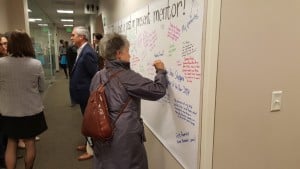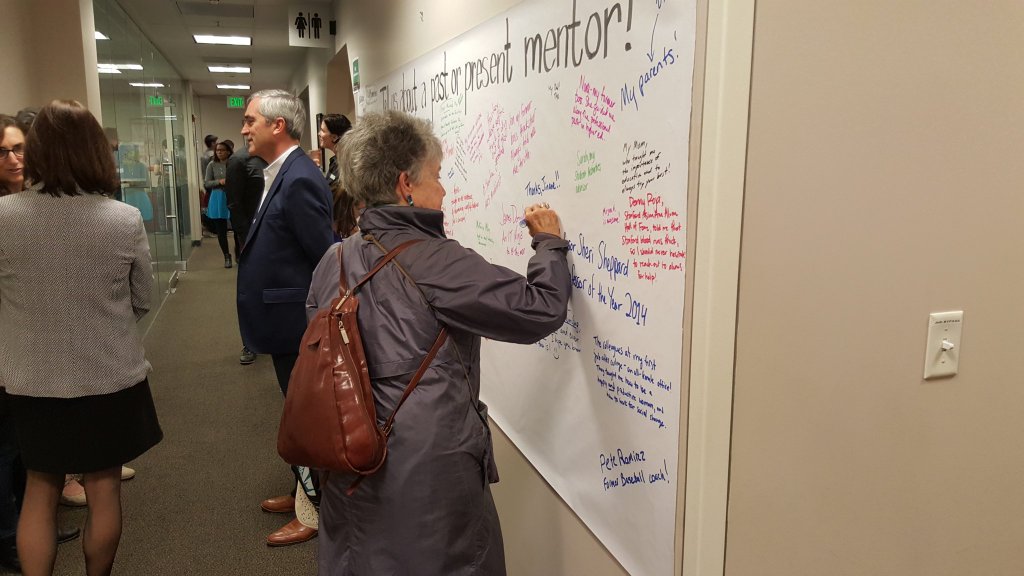
Sharing the results of its new Career Connections model, Stanford BEAM hosted the BEAM Connection event to celebrate the stories of students and alumni Thursday. The career education center underwent a rebranding last September and adopted the new philosophy of Bridging Education, Ambition, and Meaningful Work (BEAM) into its name.
The celebratory event encouraged both alumni and current students to share their career exploration stories. Employing a multimedia presentation spread across the three floors of BEAM’s building, each level prompted attendees to participate in the interactive programming.
“The whole idea of this event is to show how we’ve transformed and how we can help serve every stakeholder,” said Sheetal Patel, BEAM’s director for branding and digital communities.
BEAM partnered with undergraduates, graduates, alumni and various departments to reinvent itself from the previous Career Development Center. The current career connections model, which came out of Vision 20/20, the standard adopted by a committee in 2013, has resulted in a more effective career education service for the shifting paradigm in job markets in today’s technical age, according to Farouk Dey, dean of career education and an associate vice provost of Student Affairs. BEAM had also doubled its staff members in order to implement its more communal model.
The first floor of BEAM Connection told the story of alumni and promoted BEAM to be the hub for support students’ needs while at Stanford and after. The keynote speaker, Drue Kataoka ’00, artist, innovator and Young Global Leader of the World Economic Forum, was an art history major while at Stanford and the creator of the 100th anniversary Stanford-Cal Big Game poster along with 26 commemorative prints.
Kataoka’s art involves an ancient Japanese ink painting technique called sumi-e along with steel, mirror, brainwaves and modern mobile technologies. She is also the cofounder of Aboomba, an analytics platform, and an upcoming speaker at the 46th World Economic Forum Annual Meeting in Davos next week.
In her keynote speech, Kataoka stressed the importance of happenstance and the visualization of career paths. She recounted her story of becoming trumpeter Wynton Marsalis’ collaborator by chance because she accepted an economics teacher’s tickets to Marsalis’ jazz concert.
“Luck is important,” Kataoka said. “But the great thing is that we all have luck. The important thing is to put yourself in the way of luck. The only surefire way to not win the lottery is not to play.”
BEAM’s new career coaching model also highlights a communal effort in advising students. Rather than only using traditional one-and-one coaching sessions, the center now engages students’ own communities to provide service to impact greater aspects of student life.
“Every transformation has a story,” Dey said. “We are here today, because two years ago, we realized the world has changed in the ways people reach their personal and professional goals.”
Kataoka also saw the opportunities for career exploration provided by her peers during her time at Stanford.
“Think about mentorship not as a top-down hierarchical model,” she said. “[Instead], think about creating these super peer groups. At Stanford, you’re sitting next to the next Nobel Laureate or the next Fortune 500 CEO.”
The second floor of the celebration showcased students’ own stories through student-created whiteboard murals. Several of the murals were created by Vivienne Le ’19 over the course of three days.
Le, who was commissioned by BEAM to depict the Seattle cityscape and a large-scale San Francisco street, was partly discovered in accordance to BEAM’s “Connect” model. She had been drawing large-scale whiteboard murals of The Thinker and Hulk on Roble Hall’s lobby whiteboard. BEAM affiliates discovered those drawings and offered Le the mural work.
“It started with Roble,” Le said. “The RF, Jeff, emailed some of my works to friends and one of them [from BEAM] offered this opportunity to decorate their space and create murals.”
The depicted cities are locations of BEAM’s Career Trek, which facilitates student immersion in various industries in areas including the Bay Area, Seattle and New York City.
The third floor included an open mic that invited attendees to share their own stories, as well as a paper-covered wall for attendees to write out their definitions of meaningful work. Helping students pursue lifelong meaningful work remains a main focus for Stanford’s career education team, according to Dey.
“The outcome [of the rebranding] was transformation in every fiber of the organization,” Dey said. “But it is important to realize that at the core of who we are, [BEAM] is still the same.”
Contact Ariel Liu at aliu15 ‘at’ stanford.edu.
